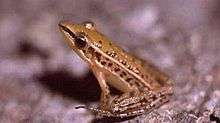Hylarana
Hylarana, commonly known as golden-backed frogs, is a genus of true frogs found in tropical Asia. It was formerly considered highly diverse, containing around 84 to 96 valid species,[2] but taxonomic revision resulted in a major change in the contents of the genus, and today it is recognised as containing just four species.
| Hylarana | |
|---|---|
 | |
| Hylarana macrodactyla | |
| Scientific classification | |
| Kingdom: | Animalia |
| Phylum: | Chordata |
| Class: | Amphibia |
| Order: | Anura |
| Family: | Ranidae |
| Subfamily: | Raninae |
| Genus: | Hylarana Tschudi, 1838 |
| Type species | |
| Hylarana erythraea Schlegel, 1837 | |
| Diversity | |
| 4 species | |
| Synonyms[1] | |
| |
Description
Hylarana are small to large-sized frogs. Males have an average snout-vent length of 27 to 85 mm (1.1 to 3.3 in), while females range from 38 to 92 mm (1.5 to 3.6 in). The nares (nostrils) are oval in shape and covered by a flap of skin. The tympanum is visible but is not covered by a supratympanic fold. Vomerine teeth and a pineal ocellus (parietal eye) are present. The toes are webbed, but the fingers are not.[2]
Distribution
Former members of the genus Hylarana ranged from Sri Lanka to the Western Ghats of India, through Nepal and southern China and Taiwan, down to Southeast Asia to the Philippines and Papua New Guinea, in Northern Australia, and tropical Africa.[3] Following taxonomic revisions, the genus is actually restricted to Southern and southeast Asia.[4]
Taxonomy
Hylarana belongs to the subfamily Raninae of the true frog family Ranidae.[1] The generic name Hylarana derives from New Latin hyle ("wood" or "forest") and rana ("frog").[2] Hylarana was previously considered to be a subgenus of the genus Rana. It was recognized as a distinct genus in 2005.[5][3] Several genera were further split from Hylarana in 2006, and then treated again as junior synonyms of Hylarana.[1] In 2015, Oliver et al.[6] performed a major taxonomic re-assessment of Hylarana. Their taxonomic reassessment left just four of the former 80–100 species within the genus Hylarana sensu stricto. The rest were transferred to Abavorana, Amnirana, Chalcorana, Humerana, Hydrophylax, Indosylvirana, Papurana, Pulchrana, and Sylvirana.
Species
Formerly, the genus consisted of around 84 to 96 valid species. Following a major re-classification, only four species are now recognised in the genus Hylarana:[4]
- Hylarana erythraea (Schlegel, 1837) - common green frog, green paddy frog, leaf frog, or red-eared frog
- Hylarana macrodactyla Günther, 1858 - Guangdong frog, three-striped grass frog, or marbled slender frog
- Hylarana taipehensis (Van Denburgh, 1909) - two-striped grass frog
- Hylarana tytleri Theobald, 1868
Following this revision, the genus assignment of several Hylarana species is now uncertain:[4]
- "Hylarana" attigua (Inger, Orlov, and Darevsky, 1999)
- "Hylarana" celebensis (Peters, 1872)
- "Hylarana" chitwanensis (Das, 1998)
- "Hylarana" garoensis (Boulenger, 1920)
- "Hylarana" lateralis (Boulenger, 1887)
- "Hylarana" latouchii (Boulenger, 1899)
- "Hylarana" margariana Anderson, 1879
- "Hylarana" montivaga (Smith, 1921)
- "Hylarana" persimilis (Van Kampen, 1923)
See also
| Wikimedia Commons has media related to Hylarana. |
| Wikispecies has information related to Hylarana |
References
- Darrel Frost and the American Museum of Natural History. "Hylarana Tschudi, 1838". Amphibian Species of the World 5.5, an Online Reference.
- S.D. Biju; Sonali Garg; Stephen Mahony; Nayana Wijayathilaka; Gayani Senevirathne; Madhava Meegaskumbura (2014). "DNA barcoding, phylogeny and systematics of Golden-backed frogs (Hylarana, Ranidae) of the Western Ghats-Sri Lanka biodiversity hotspoty, with the description of severn new species". Contributions to Zoology. 83 (4): 269–335. doi:10.1163/18759866-08304004. Archived from the original on 2016-03-03. Retrieved 2014-11-02.
- Anna Gawor; Ralf Hendrix; Miguel Vences; Wolfgang Böhme; Thomas Ziegler (2009). "Larval morphology in four species of Hylarana from Vietnam and Thailand with comments on the taxonomy of H. nigrovittata sensu lato (Anura: Ranidae)". Zootaxa. Magnola Press. 2051: 1–25. doi:10.11646/zootaxa.2051.1.1. ISSN 1175-5334.
- "Indosylvirana Oliver, Prendini, Kraus, and Raxworthy, 2015". Amphibian Species of the World: an Online Reference. Version 6.0. American Museum of Natural History. 2019. Retrieved 2019-10-05.
- Liqiao Chen; Robert W. Murphy; Amy Lathrop; Andre Ngo; Nikolai L. Orlov; Cuc Tho Ho; Ildiko L. M. Somorjai (2005). "Taxonomic Chaos in Asian Ranid Frogs: An Initial Phylogenetic Resolution" (PDF). Herpetological Journal. 15: 231–243. ISSN 1175-5334.
- Oliver, Lauren A.; Prendini, Elizabeth; Kraus, Fred; Raxworthy, Christopher J. (2015). "Systematics and biogeography of the Hylarana frog (Anura: Ranidae) radiation across tropical Australasia, Southeast Asia, and Africa". Molecular Phylogenetics and Evolution. 90: 176–192. doi:10.1016/j.ympev.2015.05.001.